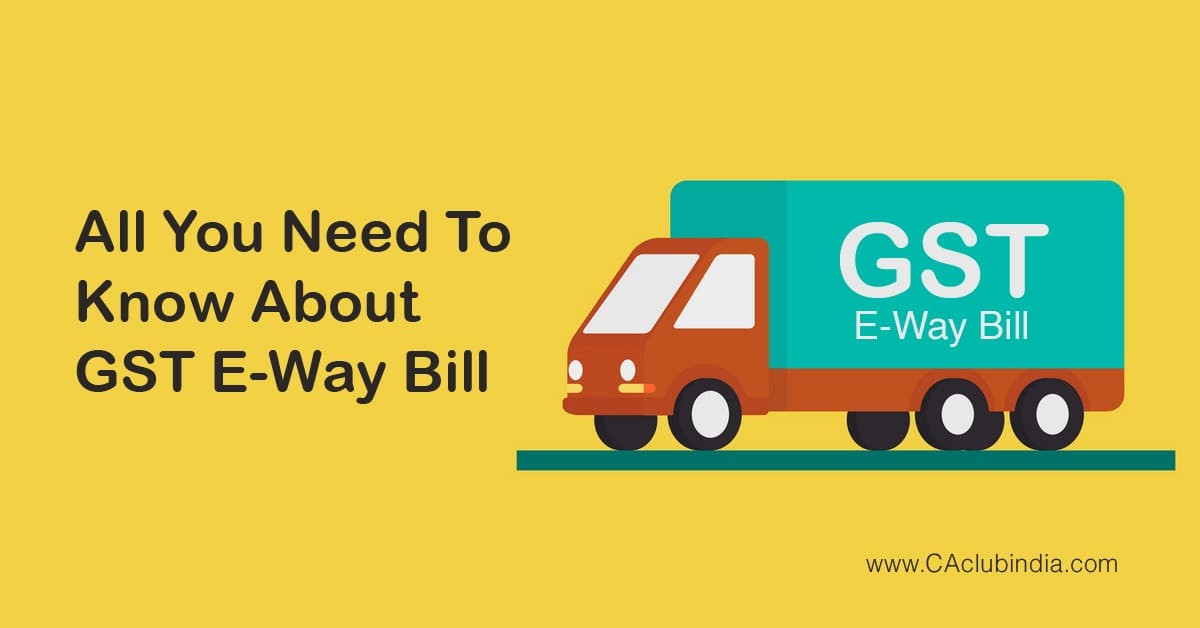Electronic-way bill or an e-way bill is a document introduced under GST (Goods and Services Tax) guidelines that have to be generated in case a business wants to ship or transport goods that are worth more than INR 50,000 within the state or interstate.
To be precise, it is a number given to every consignment that is supposed to get transported to another place within the country. The document has to be presented to the concerned authorities before the goods are in the process of being shipped or transported.
Since the bill's introduction across the country in 2018, the physical copy of this document has to be displayed by all transporters and it must have details about the name of goods carried, its weight, the destination, the name of the consignor, recipient, and the transporter as well.
In this article, we will be talking about the relevance of an e-way bill, how to generate it, its validity in India, and the documentation required to generate it.
Before going in-depth about all things related to an e-way bill, let's have a look at some of the terms you need to know beforehand to understand this concept more easily.
Carrier
A carrier is an entity that is legally eligible to transport goods from one place to another.

Waybill
A waybill is a document that is issued by a carrier that describes almost all the details regarding the consignment of goods. The details that are included in this document state the name of the goods, the consignor & consignee, its destination, point of origin, and the route taken by the carrier to name a few.
Once an e-way bill is generated, an E-way Bill Number (EBN) is issued to the supplier, transporter, and the recipient of the consignment.
Transporter ID
A transporter ID is a unique 15 digit number generated by an e-way bill system that makes the transporter eligible to apply for e-way bills.
Who should generate an e-way bill?
Regarding the generation of this bill, the person responsible for it depends on various situations. So, without further ado, let us look at the different scenarios where we will talk about who is responsible to produce the bill:
NOTE: The transporter, supplier, and the recipient are the three individuals that are taken into consideration here.
When is an E-way bill not required?
You don't need to generate an e-way bill in the following cases:
• Goods that are specified as exempt from E-way bill requirements in the respective GST rules in various States and Union Territories
• If the goods are transported from customs port, airport, air cargo complex or land customs station to Inland Container Depot (ICD) or Container Freight Station (CFS) for clearance by customs
• If the goods are being transported under customs seal or customs supervision
• If empty cargo containers are being transported
• If the goods are being transported from various custom stations or under customs bond from ICD to a customs port
• If the goods are being transported by a non-motorized conveyance
• If the value of the consignment is below INR 50,000
• If the transit cargo is transported to or from Nepal or Bhutan
• If the movement of goods is caused by the defense formation under the Ministry of Finance as a consignor or consignee
• If the goods are transported via rail by the Central Government, State Governments or any local authority
• If the goods are transported to or from between the place of business and a weighbridge for weighment with a delivery challan at a distance of 20 km
Goods that are exempt from E-way bill generation
Given below is a list of goods that are excluded from the items that are required to have an e-way bill:
- Aviation fuel
- Natural gas
- Currency
- Liquor and alcohol
- Petroleum gas
- Diesel
- Goods that come under Schedule 3 of the CGST Act
Are you figuring out whether you are eligible for an e-way bill? Take a look at the image to get a better view of it
Conditions to generate an E-way bill
To generate a bill, you have to adhere to certain conditions that are set by the Government of India:
• The bill related to the consignment should be with you at all times
• If the consignment is shipped by road, the vehicle ID or number should be present
• If the consignment is being transported by ship, air, or by rail, the transporter's ID, its document number, and the date on the document should be visible
• You should register yourself on the E-way Bill Portal
Steps to generate an E-way bill
Here is a guide on how you can generate an e-way bill online:
• Login to the E-way Bill Portal where you should enter your username and password
• Click on the “Generate New” option under the “E-way bill” dropdown
• After you are done with the second step, you will get access to an entry form where you need to fill out certain areas like what type of goods you want to ship if you are the recipient or the supplier of the goods, the document's date, type, and number.
In this step, you get to fill out relevant information on:
- Transaction type
- Sub-type
- Document type
- Document number
- Document date
NOTE: The details that you need to enter in this section depends upon what you want to ship and when. So, though the initial steps are the same for everyone, the procedure for the bill's generation from this particular step will vary.
• Once you are done with filling out all the necessary details in the form, click on “submit”. Your request for the bill will get processed and you will get access to a 12 digit number, after which further instructions will be provided to you.
The validity of the E-way bill
The validity of your e-way bill entirely depends on the distance you have traveled since it's generation.
Conveyance type Distance Validity
- For over-dimensional cargo - Less than 20 km 1 day
- For every additional 20 km or part - Additional 1 day
- For conveyance other than over-dimensional cargo - Less than 100 km 1 day
- For every additional 100 km or part - Additional 1 day
As an e-way bill generator, you can extend the validity of an e-way bill – either four hours before expiry or within four hours after its expiry.
Documents required to generate E-way bill
The primary documents required to generate an e-way bill are:
• If the goods are being transported by ship, rail, or air – The transporter ID, document number, and the date of the document
• Invoice/ Bill of supply/ Challan related to the consignment of goods
• If the goods are being transported by road – Vehicle number or transporter ID
Penalties on non-generation of E-way bill
Since the sole purpose of this bill is to eliminate the probability of tax evasion, here is a list of situations where an individual can be charged/penalized for non-generation of the bill.
• The authorities can charge the consignor a fine of INR 10,000 or the amount of tax evaded (whichever is greater) if the goods are moved without an invoice and e-way bill
• The registered person's vehicle can get seized upon inspection and will only get released when the appropriate tax and penalty is paid
Cancellation of E-way bill
In situations where the bill is generated but the goods haven't been transported, you can cancel the bill electronically through the common portal, within 24 hours of its generation.
In situations where the consignment is already confirmed to be in transit, the e-way bill, unfortunately, cannot be canceled as per the provisions of the CGST Rules, 2017.
Conclusion
The allotment of e-way bills is to eliminate the waybill systems that have been extensively used and taken advantage of in certain states in the country.
This billing system will bring in a uniform mode of transaction payments across the country, and will also pave way for further digitalization that will facilitate the movement of goods at a faster rate.







 CAclubindia
CAclubindia

